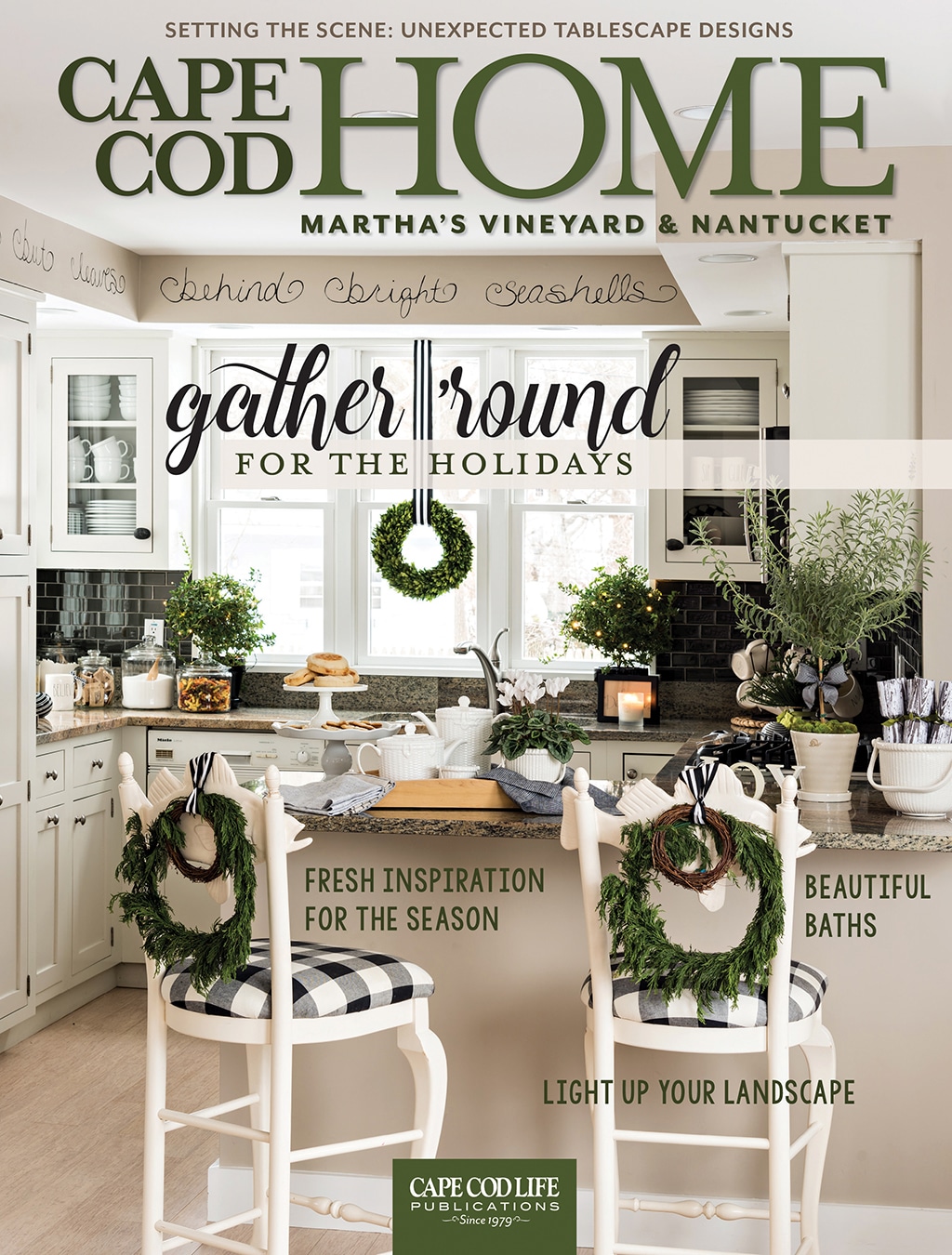
Next Wave: Nathan Adams, Cataumet Sawmill
Cape Cod Home / Winter 2018 / Home, Garden & Design, People & Businesses
Writer: Haley Cote / Photographer: Teagan Anne
Next Wave: Nathan Adams, Cataumet Sawmill

Cape Cod Home / Winter 2018 / Home, Garden & Design, People & Businesses
Writer: Haley Cote / Photographer: Teagan Anne
As the general manager of a small business, Nathan Adams, 34, is often required to do a little bit of everything at Cataumet Sawmill, from fixing equipment and stacking wood, to sales and accounting. “I sweep the floor if that’s what needs to be done,” he says with a smile. It’s that level of investment in a company that Adams, son of Cataumet Sawmill owner Tom Adams, sought after spending 10 years working as a construction engineer. “It’s interesting… You have a family of your own, but then, at least here, you have another small family that you look after,” he says of his team of five. “It’s more than just coming to work every day. That’s part of the reason I wanted to work here.”
CCH: What appealed to you about working for a sawmill company in particular?
NA: It’s creative work, because of the nature of reclaimed wood, and even because of the builders and clientele on Cape Cod in general. People are doing things that aren’t just typical renovations of a house. They want unique materials. Sometimes we do the same flooring, beams and countertops that we normally do, but here and there, when someone wants something different, then you get to put your own touch on it. And sometimes you might never do a piece quite like the one before. It’s nice to have that variety.
CCH: You work directly with clients to design custom reclaimed pieces. How do you approach that collaboration?
NA: You have to feel out the client and how much character they’re OK with, or what level of refinement they want in a piece. I show them color tones of what it could be, and then I show them a piece in the yard—the stock material, if you will—and what they’re going to start with. I think the story behind a piece is important, and if they respond to that, then they’ll understand that they’re getting something unique and to their liking.
CCH: That’s neat to know the story behind the wood and where it came from—and speaking of stories, you’re creating something that’s going to be a part of a person’s life and the history of their home.
NA: It could even be the first antique they put in their home, so the stories behind each piece can be important. We’ve had customers, for example, who’ve served in the Navy, and there happens to be timbers in the yard from the Chelsea Clock building, which originally made the round brass clocks that go inside the Navy ships. There’s other material here from the Fore River Shipyard in Quincy, and that’s where the naval station is there. So sometimes those pieces hold a special significance to people. If we can identify an interest that they have and relate a piece of lumber that we have in the yard to one of their interests, or their past, that’s the link they’re looking for. We try to create that experience so that when they see that same beam or floor throughout the rest of their life, they’re recalling that memory. I think that’s the reason why we’re able to maintain our clients. We have such a good rapport with customers because our products have made an impact.
CCH: In your two years as general manager, what have you found to be key in running this business successfully?
NA: We’re dealing with old material, older growth materials that only can be found through reclaim, so that requires a network that you can never build in two years. I’m the beneficiary of 30-plus years in business that my father and his late partner, Ted Wolf, have pulled together. That was built over a long time of being reliable and being trustworthy in years of doing business with people who you can source this material from. To learn how that world works, and then bring the experience I’ve had with newer technology and ways of doing business—to bring those two worlds together to maintain how this is an old-fashioned sawmill but bring it up to speed to still reach customers is the major challenge. I feel that so far we’ve done a good job of doing that. For example, having an office, which never existed until a couple months ago. And having a website within the last two years—that really has become the main way we reach our customers now.
CCH: What would you say is the most important thing you’ve learned about the industry from your father?
NA: To do what you say you’re going to do. And that might be universal to any business, but somehow, someway, that doesn’t always happen. To truly be that way, that’s how you build a reputation of trust and reliability, which is vital to being able to do business in the reclaimed world. And then there’s the tacit knowledge of understanding what’s a good piece of wood, and what’s not a good piece of wood. They may all look the same from 10 feet away, but then you take a closer evaluation of what’s there in front of you when you’re purchasing the timber, and sometimes it’s good, sometimes it’s not. There are small telltale signs that you have to look for, and that’s vitally important too.
CCH: Why do you prefer to work with reclaimed woods?
NA: Old-growth timber grew a lot slower than any timber that’s harvested now. Particularly antique heart pine, which essentially doesn’t grow anymore—it was harvested all the way to the brink of extinction. There are few reserves still left where it’s not harvested. So the wood is a lot more stable and a lot denser than the typical pine that you’d find today. That creates a floor that moves a whole lot less. Antique heart pine is as hard as oak, whereas today’s normal white pine is very soft. Then there’s the appearance, the coloration. If you look at the growth rings on old-growth wood across any species, it’s a lot tighter grain, and that’s a result of growing in prime forests. They’ve had hundreds and hundreds of years to grow, rather than being harvested every 20 to 30 years. As a result, the material that you start with is just a superior wood to anything that is harvested now.
CCH: Of the woods you work with, do you have a favorite?
NA: I am partial to antique heart pine. I actually like our lower grade because it has more character and more dynamic going on with the wood in the colors and the grain and the knots. There’s a story to tell. And I feel like each grade of heart pine has its place in a house, as flooring or paneling.
CCH: How do you enjoy spending your time outside of work here on the Cape?
NA: Fishing with my son and with my father—that’s paramount. I enjoy my two-day weekends, which I never used to have. I like getting outside, basically to do anything—even if it’s chores around the yard, and it’s important for me to include my son in that process. It might go slower, but it’s good that he’s there to learn.
CCH: What advice would you give fellow young professionals looking to succeed on the Cape?
NA: You can benefit from working for a large company right off the bat. After a while, you understand the process, you understand essentially what the cutting edge is, and then you can take a step back and pursue your own ventures. And remember what it’s like when you’re first starting. My first mentor told me to write down what it is I wished my bosses would do, and what they did well. That would help me later on in my professional career. It helps you understand how you should conduct yourself, and how clients or employees receive you.
CCH: In thinking of the bosses you’ve previously had, what’s been the biggest takeaway that you’ve incorporated into how you run this business?
NA: It’s very important to give your employees a sense of stability, especially in a bad situation. To maintain your poise, even though that can be very hard at times, and to give them confidence in you. Then they’ll feel more secure, and they’re going to make better decisions because they feel comfortable.




